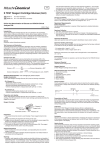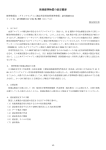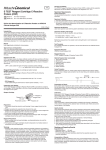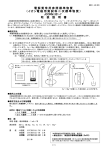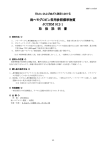Download S TEST Reagent Cartridge Triglycerides (TG (
Transcript
S TEST Reagent Cartridge Triglycerides (TG ( 96309-10 96309-100 10 S TEST Cartridges 10 x 10 S TEST Boxes (100 Tests) Kit for the determination of Triglycerides on HITACHI Clinical Analyzer E40 2012-11 Rev.1 Intended Use The S TEST Reagent Cartridge Triglycerides (TG) is intended for the quantitative determination of triglyceride concentration in serum or heparin plasma using the HITACHI Clinical Analyzer E40. The S TEST Reagent Cartridge Triglycerides (TG) is intended for use in clinical laboratories or physician office laboratories. For in vitro diagnostic use only. Method Enzymatic method (GPO-POD method without Free Glycerol) Test Summary and Explanation Triglyceride is composed of glycerol that is esterified with three molecules of fatty acid, and is known to be a major component of fat throughout the body. The measurement of triglyceride is considered useful to detect abnormal lipid metabolism. Especially, its relationship with arteriosclerosis and coronary artery disease has been given much attention. Principle of the Test Triglyceride in samples is rapidly hydrolyzed into glycerol and fatty acid by the lipoprotein lipase (LPL). The resulting glycerol is converted into glycerol-3-phosphate by the action of Glycerokinase (GK) in the presence of ATP. The glycerol-3phosphate is then degraded by L-α-Glycerophosphate oxidase (GPO) to produce hydrogen peroxide. In the presence of peroxidase (POD), 4-aminoantipyrine and N,N-Bis(4-sulfobutyl)-3-methylaniline disodium salt (TODB) are subjected to oxidation condensation by the hydrogen peroxide to form a purple-red pigment. The concentration of triglyceride can be determined by measuring the absorbance of the resulting purple-red pigment. Triglyceride Glycerol + ATP LPL GK Mg2+ Glycerol-3-phosphate + O2 GPO H2O2 + TODB + 4-Aminoantipyrine POD Storage and Stability The S TEST Reagent Cartridge Triglycerides (TG) is stable until the expiration date shown on the box labels when stored in the refrigerator at 2 – 8 °C. Specimen Requirements Patient Preparation No special patient preparation is required. Collect specimen by standard laboratory technique. Specimen Collection 1.Use clear, unhemolyzed serum or heparin plasma. 2.Care should be taken to preserve the chemical integrity of the blood specimen from the time it is collected until the time it is assayed (see SPECIMEN HANDLING AND STORAGE). Specimen Identification Label each specimen tube with the patient's identification (name and/or number). Specimen Handling and Storage If not tested on the day of collection, store as follows 1: • For testing within 1 week: 2 – 10 °C • For testing after 1 week or longer: below -20 °C Before the measurement, the sample must be brought back to room temperature (15 – 30 °C). Glycerol + Fatty acid Glycerol-3-phosphate + ADP Equipment Required HITACHI Clinical Analyzer E40 H2O2 + Dihydroxyacetone phosphate Reagent Required S TEST Reagent Cartridge Triglycerides (TG) Purple-red pigment Reagent Composition The S TEST Reagent Cartridge Triglycerides (TG) has the following composition: TG Reagent (1): • Adenosine 5'-triphosphate disodium salt 3.0 mmol/L • Glycerokinase (Flavobacterium meningosepticum) 1.0 IU/mL • L-α-Glycerophosphate oxidase (Streptococcus sp.) 6.0 IU/mL • N,N-Bis(4-sulfobutyl)-3-methylaniline disodium salt 1.0 mmol/L • Catalase (Micrococcus lysodeikticus) 800 U/mL • Good’s buffer (pH 6.5) 50 mmol/L TG Reagent (2): • Lipoprotein lipase (Chromobacterium viscosum) 100 IU/mL • 4-Aminoantipyrine 1.6 mmol/L • Peroxidase (Horseradish) 30 U/mL • Good’s buffer (pH 6.2) 50 mmol/L Preparation and Labeling The S TEST Reagent Cartridge Triglycerides (TG) is provided in a ready-to-use cartridge. The 2D code label on the front of each cartridge automatically identifies the reagent to the system. Reagent Cartridge Photometric cuvette Warnings 1. Samples, used reagents and other waste are potentially infectious and capable of transmitting human immunodeficiency virus (HIV), hepatitis B virus (HBV) and other infectious diseases. Avoid immediate contact. The handling and disposal of patient samples, reagents and liquid waste must be performed according to local, national, and international laboratory safety and waste disposal regulations. This includes wearing gloves and appropriate splash protection, etc. If these substances come in contact with skin, rinse with ample water, disinfect, and consult a physician. 2. TG Reagent (2) contains sodium azide, an antiseptic which may be irritating to eyes, skin and mucous membranes. Sodium azide may react with copper and lead plumbing to produce explosive metal azide; flush with copious amounts of water if disposing down the drain. Test Procedure For complete information on operation, see the User Manual for the HITACHI Clinical Analyzer E40. Reagent Requirements- one cartridge per patient sample Reagent (2) 2D code Disposal Precautions 1. When handling blood and used cartridges, use disposable gloves to avoid the danger of infection. 2. The samples and reagent cartridges should be disposed of as medical wastes in accordance with local regulations. Reagent (1) Reagent cells Reaction cell Precautions 1. This product should be stored to avoid freezing. Frozen reagent should not be used. 2. Reagent exceeding the expiration date should not be used. 3. Reagent kits are intended for single use only. Do not attempt to reuse reagent kits. Discard any damaged reagent kits or kits that arrive opened. 4. Avoid direct sunlight during storage and measurement. 5. This product is intended for use on HITACHI Clinical Analyzer E40. The reagent cartridges should not be used for any other purposes. Material Required (but not provided) 1. Two levels of controls 2. Sample cups 3. Disposable transfer pipettes 4. Washing water 5. Alkali detergent 6. Waste container Assay Procedure Prior to performing each run, check system status to determine the need to replace washing water or empty waste container. See the User Manual for detailed operating instructions. Measurement (570 / 700 nm) Reagent (1) / Sample 210 μL / 5 μL 0 Measurement (570 / 700 nm) Reagent (2) 70 μL 7.0 7.5 Conc. Calculation 12.5 (min) Wavelength: (main/sub) Presentation of Result Each patient report includes the data and time, sample ID number (as programmed), the test abbreviation, the test results, normal ranges and result flags. For detailed explanations on flags and error messages, refer to the User Manual for the HITACHI Clinical Analyzer E40. Calibration Each lot of S TEST Reagent Cartridge Triglycerides (TG) is calibrated by the manufacturer prior to shipment using material traceable to ReCCS (Reference Material Institute for Clinical Chemistry Standards) standard serum JCCRM 224. The 2D code printed on each cartridge provides the analyzer with lot-specific calibration data. Calculation Triglyceride concentration is directly determined by multiplying the change in absorbance of the unknown samples by the calibrator factor on the 2D code. Patient and control results appear on the display. Quality Control Users should follow federal, state and local regulatory requirements regarding quality control practices. See instrument manual for procedures on how to run controls. Good laboratory practice includes the use of at least two levels of control material to ensure the test performance. The frequency and limits of QC testing should be determined according to individual laboratory standard QC procedures. Controls should be run at least once every 30 days and: 1. When test results do not match patient symptoms or clinical findings. 2. When using a new lot or shipment of reagents. 3. When laboratory environmental conditions have significantly changed. 4. When training or retraining of personnel occurs. 5.After specific maintenance on trouble shooting steps described in the User Manual for the HITACHI Clinical Analyzer E40. Reading and Reporting Results Please note: this assay has not been certified by the Cholesterol Reference Method Laboratory Network (CRMLN), but is traceable to the CRMLN method. Expected Value • Reportable range: 7 – 800 mg/dL • Reference range: 30 – 150 mg/dL 2 • Normal: <150 mg/dL, Borderline high: 150 – 199 mg/dL, High: 200 – 499 mg/dL, Very high: ≥500 mg/dL 3 • It is recommended that each laboratory determine the expected values for its particular population. Interpretation of Results There may be reactions with non-target substances or interfering reactions. If measured results seem unreliable, repeat the measurement (if necessary after dilution) or try another analytical measurement. Range Regression (mg/dL) Equation 111 19 to 761 y = 1.04x + 6.7 CI = 95% confidence interval n “r” 0.99 CI* Slope 1.03 to 1.05 CI* Intercept 4.4 to 9.0 Serum/Plasma Comparison Study A study was performed to validate the use of heparinized plasma as well as serum for the Hitachi Clinical Analyzer E40 with the S TEST Reagent Cartridge Triglycerides (TG). 39 matched serum/plasma samples that spanned the dynamic range were assayed in singleton and the results were compared using least squares liner regression (plasma = y-axis). The performance characteristics were as follows. y = 1.00x -1.3 correlation coefficient (r) = 0.99 95% confidence interval of the slope = 0.98 to 1.00 95% confidence interval of the y-intercept = -4.7 to 2.1 Detection limit (per CLSI EP17-A) The detection limit was determined to be 2.5 mg/dL. The quantitation limit was determined to be 7 mg/dL. Reportable Range 7 mg/dL to 800 mg/dL Handling Critical Values If the result of a sample exceeds the measurement range, dilute the sample with physiological saline solution, and repeat the measurement. Routine Maintenance and Troubleshooting For complete information on operation, see the User Manual for the HITACHI Clinical Analyzer E40. Performance Characteristics Technical Support/ Instrument Service 1.First contact your local distributor 2.Hitachi Chemical Co., Ltd. (Japan) Interference (per CLSI EP7-A2) The data demonstrated that the TG test system was not affected by high levels of the following substances at the levels noted: Hemoglobin: no interference up to 500 mg/dL Unconjugated bilirubin: no interference up to 50 mg/dL Ascorbic acid: no interference up to 50 mg/dL Lack of interference was defined as recoveries between 90% and 110% of the neat value, and assay performance claims were established on the HITACHI Clinical Analyzer E40 by testing two serum pools containing approximately 100 mg/dL and 180 mg/dL TG. The information presented is based on results from Hitachi studies and is current at the date of publication. Hitachi makes no representation about the completeness or accuracy of results generated by future studies. Precision (per CLSI EP5-A2) Four levels of serum samples were assayed 2 times per run, 2 runs per day, for total of 20 days. The precision was found to be: Level 1 2 3 4 n= 80 per level Mean (mg/dL) 33 130 367 620 SD (mg/dL) 1.8 3.4 9.1 14.8 %CV 5.6 2.6 2.5 2.4 Reference 1.Sasaki, M. and coauthors: Sampling of chemical components of the human body, Kodansha, p.264 (1972) 2.Extensive chemical analysis of blood and urine, immunological examination: Japanese Journal of Clinical Medicine 57, Special Issue (1999) 3.Third Report of National Cholesterol Education Program (NCEP) Expert Panel on Detection, Evaluation and Treatment of High Cholesterol in Adults (Adult Treatment Panel III); Executive Summary (2002) 4.CLSI Document EP5-A2, Evaluation of Precision Performance of Quantitative Measurement Methods, Approved Guideline 5.CLSI Document EP6-A, Evaluation of Linearity of Quantitative Measurement Procedures, Approved Guideline 6. CLSI Document EP7-A2, Interference Testing in Clinical Chemistry, Approved Guideline 7.CLSI Document EP17-A, Protocols for the Determination of Limits of Detection and Limits of Quantitation, Approved Guideline Precision (POL sites) Three levels of samples (A, B and C) were tested by three POL sites, six times a day for five days. The precision estimates are described below. Site # Sample Mean 1 A 32 2 A 34 3 A 31 1 B 115 2 B 120 3 B 115 1 C 291 2 C 302 3 C 289 n = 30 replicates per sample per site Within-run Precision SD (mg/dL) %CV 0.8 2.6 1.1 3.3 1.2 4.0 3.0 2.6 1.4 1.2 2.2 1.9 1.9 0.7 3.7 1.2 2.5 0.9 Total Precision SD (mg/dL) %CV 1.1 3.4 1.1 3.3 1.3 4.1 3.5 3.0 1.5 1.3 2.8 2.4 3.4 1.2 3.5 1.2 3.3 1.1 Patient Correlation (POL sites) A series of approximately 50 serum specimens with triglycerides values ranging from 21 to 712 mg/dL were assayed on the HITACHI Clinical Analyzer E40 at three sites using the S TEST Reagent Cartridge Triglycerides (TG) (y) and a comparative method as the reference method (x). Linear regression analysis (least squares) yielded the following results: Site Range Regression n # (mg/dL) Equation 1 52 36 to 619 y = 1.05x +4.9 2 52 21 to 712 y = 0.94x +3.3 3 51 35 to 605 y = 1.07x -6.5 CI = 95% confidence interval “r” 0.99 0.99 0.99 CI* Slope 1.04 to 1.07 0.93 to 0.96 1.05 to 1.10 CI* Intercept 1.4 to 8.4 0.1 to 6.5 -10.1 to -2.9 Patient Correlation (laboratory site) A series of 111 serum specimens with triglycerides values ranging from 19 to 761 mg/dL were assayed on the HITACHI Clinical Analyzer E40 using the S TEST Reagent Cartridge Triglycerides (TG) (y) and a comparative method as the reference method (x). Linear regression analysis (least squares) yielded the following results: 80-7870-00-01 04/13 2-1-1, Nishi-Shinjuku, Shinjuku-ku, Tokyo 163-0449, Japan


